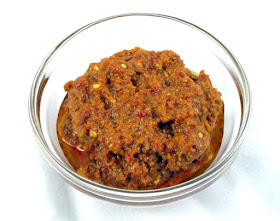Harissa is a classic dried red chili based sauce in North African cooking, and it is often what gives the regional vegetable dishes, soups and stews their distinct fieriness. It's also used as a spicy hot condiment to dress eggs, couscous and flatbreads or to whisk into salad dressings. But harissa is more than just heat, despite the large number of chilies that go into it. Harissa has a unique flavor all of its own from garlic, cumin and caraway seeds, and sometimes tomatoes as well.
Like most traditional foods, there are countless variations of harissa made in kitchens all across North Africa, and I have shared one such version previously. This one is different, however, and has a deeper flavor due to the addition of sun-dried tomatoes and some lemon juice for a bit of refreshing zest to compliment the aromatic and fiery heat of the chilies. Other optional enhancements that are often added are roasted red peppers, saffron, mint, or even rose petals.
However you make harissa, be sparing with it at first until you're used to the heat. This harissa is easy to prepare if you use a blender or food processor rather than the traditional method of grinding the ingredients with a mortar and pestle. It keeps well for up to two months when stored in a jar with a tight-fitting lid and with olive oil poured over the top.
 Homemade Harissa Homemade Harissa |
| Recipe by Lisa Turner Cuisine: North African Published on May 26, 2019 The traditional Tunisian condiment of red chilies and spices is easy to make at home and adds flavorful heat to vegetables, soups, stews and salad dressings Preparation: 10 minutes  Print this recipe Print this recipeIngredients:
|
Other ethnic condiments and spice blends from Lisa's Kitchen:
Homemade Za'atar
Classic Tamarind Chutney
Fresh Coconut Chutney with Tamarind and Cilantro
Basic Fresh Salsa
Mexican Tomato and Jalapeño Salsa


Its been a while since I have both used harissa and made harissa from scratch, you recipe is very different from mine - but I like it! Hope your well and enjoying the w/e
ReplyDeleteWhat type of dried chilies do you use (or recommend)?
ReplyDeleteIt depends on what is available, but usually the skinny red ones. Sometimes Kashmiri chilies, which are not quite as hot, and other times, I purchase them in bags at an Indian grocer, and they are labeled as Indian red chilies. It really depends on how much heat you want, and accordingly, adjust the recipe somewhat with that in mind.
ReplyDelete